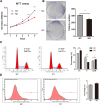High MLL2 expression predicts poor prognosis and promotes tumor progression by inducing EMT in esophageal squamous cell carcinoma
- PMID: 29532228
- PMCID: PMC5948284
- DOI: 10.1007/s00432-018-2625-5
High MLL2 expression predicts poor prognosis and promotes tumor progression by inducing EMT in esophageal squamous cell carcinoma
Abstract
Background: MLL2 has been identified as one of the most frequently mutated genes in a variety of cancers including esophageal squamous cell carcinoma (ESCC). However, its clinical significance and prognostic value in ESCC has not been elucidated. In the present study, we aimed to investigate the expression and role of MLL2 in ESCC.
Methods: Immunohistochemistry (IHC) and qRT-PCR were used to examine the expression profile of MLL2. Kaplan-Meier survival analysis and univariate and multivariate Cox analyses were used to investigate the clinical and prognostic significance of MLL2 expression in Kazakh ESCC patients. Furthermore, to evaluate the biological function of MLL2 in ESCC, we applied the latest gene editing technique CRISPR/Cas9 to knockout MLL2 in ESCC cell line Eca109. MTT, colony formation, flow cytometry, scratch wound-healing and transwell migration assays were performed to investigate the effect of MLL2 on ESCC cell proliferation and migration. The correlation between MLL2 and epithelial-mesenchymal transition (EMT) was investigated by Western blot assay in vitro and IHC in ESCC tissue, respectively.
Results: Both mRNA and protein expression levels of MLL2 were significantly overexpressed in ESCC patients. High expression of MLL2 was significantly correlated with TNM stage (P = 0.037), tumor differentiation (P = 0.032) and tumor size (P = 0.035). Kaplan-Meier survival analysis showed that patients with low MLL2 expression had a better overall survival than those with high MLL2 expression. Multivariate Cox analysis revealed that lymph node metastasis and tumor differentiation were independent prognostic factors. Knockout of MLL2 in Eca109 inhibited cell proliferation and migration ability, induced cell cycle arrest at G1 stage, but it had no significant effect on apoptosis. In addition, knockout of MLL2 could inhibit EMT by up-regulation of E-Cadherin and Smad7 as well as down-regulation of Vimentin and p-Smad2/3 in ESCC cells. In cancer tissues, the expression of E-Cadherin was negatively correlated with MLL2 expression while Vimentin expression was positively correlated with MLL2 expression.
Conclusion: Our results indicate that overexpression of MLL2 predicts poor clinical outcomes and facilitates ESCC tumor progression, and it may exert oncogenic role via activation of EMT. MLL2 may be used as a novel prognostic factor and therapeutic target for ESCC patients.
Keywords: EMT; Esophageal squamous cell carcinoma (ESCC); MLL2/KMT2D; Prognosis; TGF-β/Smad.
Conflict of interest statement
All the authors declare that they have no conflict of interest.
Figures





References
MeSH terms
Substances
Grants and funding
LinkOut - more resources
Full Text Sources
Other Literature Sources
Medical
Miscellaneous

